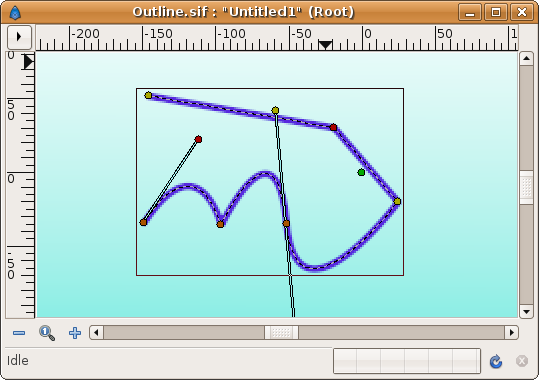Livello Contorno
m |
m |
||
| Line 31: | Line 31: | ||
|- | |- | ||
||{{l|Image:type_integer_icon.png|16px}} {{l|Blend Method|Metodo Miscela}} | ||{{l|Image:type_integer_icon.png|16px}} {{l|Blend Method|Metodo Miscela}} | ||
| − | || | + | ||Composito |
||intero | ||intero | ||
| Line 169: | Line 169: | ||
| − | == Parametri specifici per i Livelli Contorno == | + | ==Parametri specifici per i Livelli Contorno== |
| − | + | I primi 11 parametri del Contorno sono parametri comuni condivisi con molti tipi di Livelli. Clicca sul collegamento per vedere le loro definizioni. Vengono qui descritti solo i parametri con particolarità relative al Livello Contorno. | |
| − | + | Questa è una videata di esempio d'utilizzo di un Livello Contorno: | |
{{l|Image:Outline_Sample.png}} | {{l|Image:Outline_Sample.png}} | ||
| − | === | + | ===Ampiezza Contorno=== |
| − | + | Il parametro Ampiezza Contorno è di tipo flottante in pixel che indica il valore base dell'ampiezza per tutti i punti della curva insieme. Lavora insieme con il parametro d'ampiezza dei valori dei vertici dei figli. Così impostando l'Ampiezza Contorno a 1.0px il valore risultante ottenuto per l'ampiezza ottenuta per quel vertice sarà ottenuta da questa formula: W = OLW * VW + 2E. | |
| − | + | Dove: | |
| − | * W = | + | * W = ampiezza [W:width] risultante del contorno del vertice. |
* OLW = overall parameter for the width of all the vertices (that is the Outline Width parameter). | * OLW = overall parameter for the width of all the vertices (that is the Outline Width parameter). | ||
* VW = specific vertex width value. | * VW = specific vertex width value. | ||
Revision as of 16:16, 2 September 2011
|
Warning! This page contains outdated information. The release of Synfig Studio 0.64.0 introduced new terminology and this translated page needs to be updated according to original English text. You can help updating this page - see instructions here. Thank you! |
Contents
Relativamente ai Livelli Contorno
I Livelli Contorno sono usati per evidenziare tratti o bordi di forme piene. I contorni danno un aspetto di cartone animato quando associati ai bordi delle forme. Anche i soli contorni (pennellate) sono usati per definire pieghe di disegni 3D ed usati assieme alle ombre (generate usando gradienti di sfumatura) sono le basi del lavoro di un artista.
Per generare un Livello Contorno, usa lo Strumento Contorno e spunta la casella Contorno nel Pannello Opzioni Strumenti. Una volta terminata la definizione della geometria del contorno e dopo aver premuto "Genera Linea Bézier (BLine) e/o Regione" (o selezionato un'altro strumento o stato) viene generato il Livello Contorno con l'attuale colore di primo piano.
Parametri dei Livelli Contorno
I parametri dei Livelli Contorno sono:
| Nome | Valore | Tipo |
| 0.000000 | reale | |
| 1.000000 | reale | |
| Composito | intero | |
|
|
colore | |
| 0.000000u,0.000000u | vettore | |
|
|
booleano | |
|
|
booleano | |
| 0.000000pt | reale | |
| Sfocatura Gaussiana Veloce | intero | |
| Non Zero | intero | |
| Lista | lista (BLinea) | |
| 2.000000pt | reale | |
| 0.000000pt | reale | |
|
|
booleano | |
|
|
booleano | |
|
|
booleano | |
| 1.000000 | reale | |
|
|
booleano |
Parametri specifici per i Livelli Contorno
I primi 11 parametri del Contorno sono parametri comuni condivisi con molti tipi di Livelli. Clicca sul collegamento per vedere le loro definizioni. Vengono qui descritti solo i parametri con particolarità relative al Livello Contorno.
Questa è una videata di esempio d'utilizzo di un Livello Contorno:
Ampiezza Contorno
Il parametro Ampiezza Contorno è di tipo flottante in pixel che indica il valore base dell'ampiezza per tutti i punti della curva insieme. Lavora insieme con il parametro d'ampiezza dei valori dei vertici dei figli. Così impostando l'Ampiezza Contorno a 1.0px il valore risultante ottenuto per l'ampiezza ottenuta per quel vertice sarà ottenuta da questa formula: W = OLW * VW + 2E.
Dove:
- W = ampiezza [W:width] risultante del contorno del vertice.
- OLW = overall parameter for the width of all the vertices (that is the Outline Width parameter).
- VW = specific vertex width value.
- E = value of the Expand parameter.
The width duck would show the radius value for that vertex (W/2).
The width that ends up being used for each vertex is ((VertexWidth * OutLineWidth) + Expand*2):
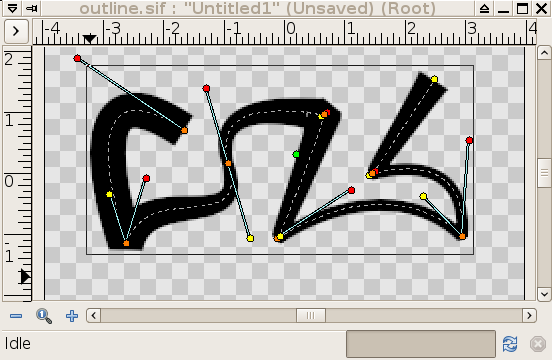
|
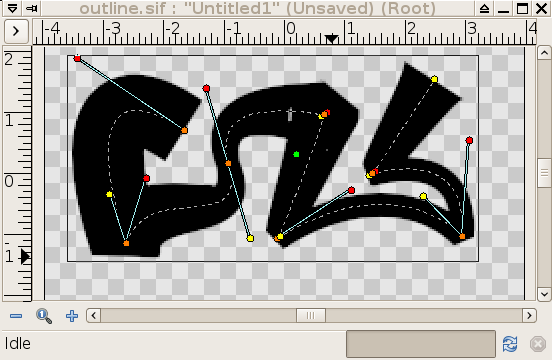
|
| starting image | after doubling the value of 'outline width' |
It's possible to specify negative values for the width values, which kind of turns the vertex inside out. Here's an example where the left vertex has a negative width and the right has a positive width. Note how the edges of the bline between the vertices cross each other in the middle:
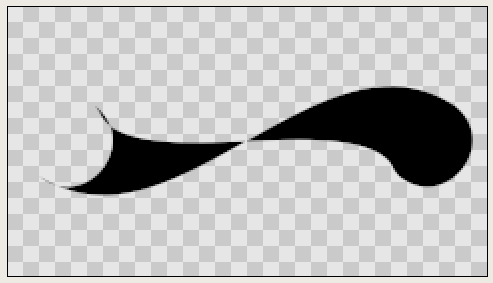
|
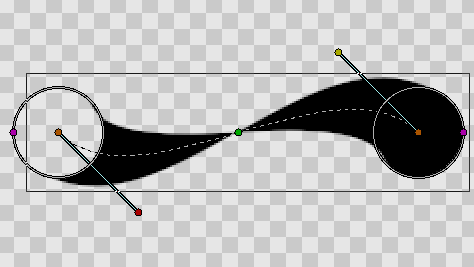
|
Expand
The Expand parameter is similar to the Outline Width parameter, but rather than being multiplied by each vertex's width, it is added to the radius of each vertex. In other words (2*Expand) is added to the diameter of each vertex.
The width that ends up being used for each vertex is ((VertexWidth * OutLineWidth) + Expand*2):

|
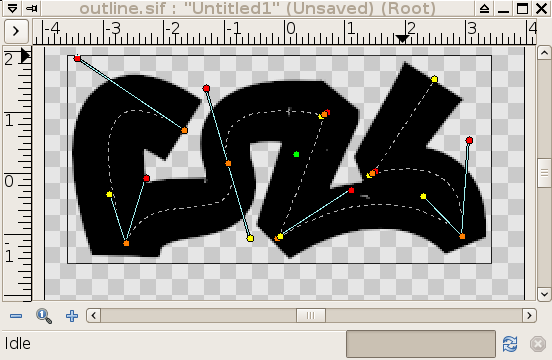
|
| zero 'expand' | non-zero 'expand' |
Sharp cups
Enabling 'sharp cusps' makes the corners pointy when the tangents are split:

|
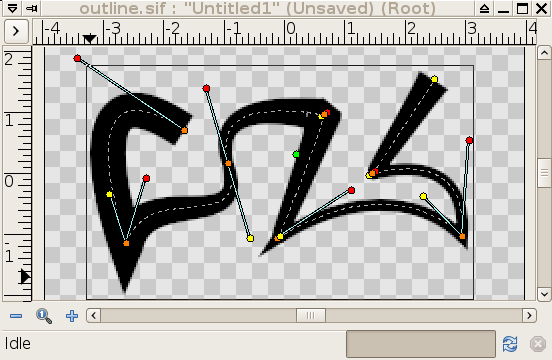
|
| no sharp cusps | sharp cusps |
Rounded Begin
Enabling 'rounded begin' makes the start of the outline rounded:

|
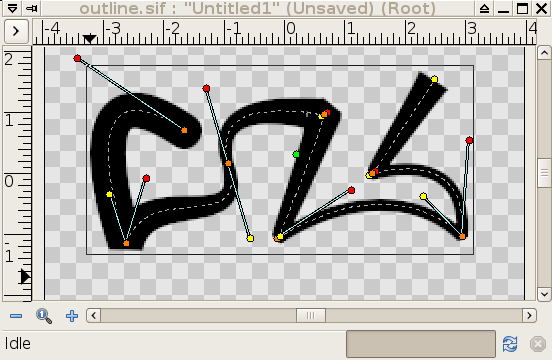
|
| no rounded begin | rounded begin |
Rounded End
Enabling 'rounded end' makes the end of the outline rounded:

|
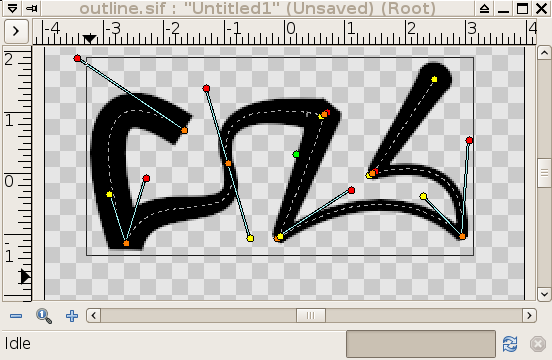
|
| no rounded end | rounded end |
Loopyness
This parameter currently does absolutely nothing at all!
Homogeneous
Enabling 'Homogeneous' changes the way that the width of the outline changes from one blinepoint to the next. Each point in the bline has its own width, and the bline has its own 'Outline Width' and 'Expand' parameters which are used to give the final width at each blinepoint. The 'Homogeneous' parameter controls how the width is interpolated between two neighbouring blinepoints:
- When 'Homogeneous' isn't checked, the width is interpolated linearly with the spline's 't' parameter.
- When 'Homogeneous' is checked, the width is interpolated linearly with the spline's length.
Turning off homogeneous often makes the fat end of a bline look lumpy. Maybe that's a bug:
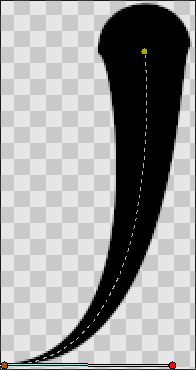
|
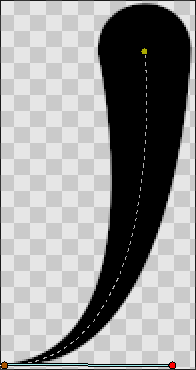
|
| not homogeneous | homogeneous |
Misc
The 'antialias' checkbox isn't specific to the Outline layer, but it is particularly useful for the Outline layer. It makes the edges appear smoother:
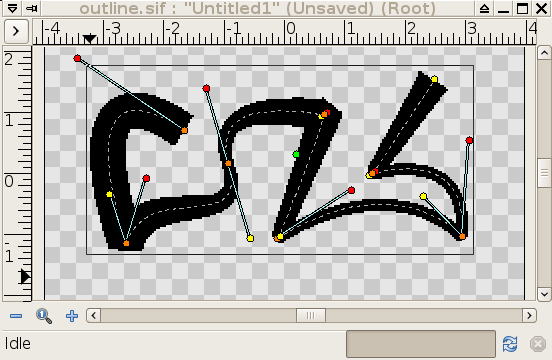
|

|
| not antialiased | antialiased |
